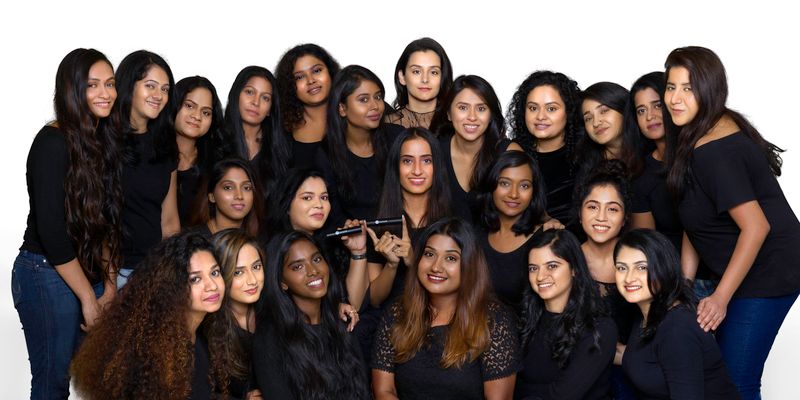SUGAR Cosmetics, a direct-to-consumer cosmetics brand co-founded by IIM alumnus Vineeta Singh in 2015, became one of the leading makeup brands among customers by selling its signature Scarlett O'Hara lipsticks and foundations in most Indian skin tones.
Four years later, in FY2019-20, the brand managed to clock Rs 100 crore in annual revenue, which legacy cosmetic brands like Revlon took 20 years to reach in India. This feat was achieved due to the D2C brand’s willingness to sell products with an omnichannel approach, focusing on content marketing, and developing its own app, among many other initiatives.
While most cosmetic brands in India were struggling during the pandemic, SUGAR saw 70-80 percent of sales coming from online channels. After initial hiccups, the brand claims to have recorded its highest sales of more than 60 percent in November 2020 compared to pre-Covid sales by focusing on ecommerce.
As the pandemic continued, most D2C brands preferred to stay online as malls and retail stores across the country remain shut. Even SUGAR’s retail sales have been down to less than 10 percent.
But Vineeta Singh, CEO and Co-founder of SUGAR Cosmetics, says, the company’s focus on retail will continue to dominate the sales channel over the next few years.
The startup also managed to raise $21 million funding in February 2021, which reinforces the company’s strong fundamentals backed by its investors, who are pushing for more retail presence during the pandemic.
The company, which has more than 10,000 retail touchpoints, including a presence across modern trade stores and kiosks, strongly believes that it gets good brand visibility due to its offline presence.
In a conversation with YourStory, Vineeta talks about having a strong retail presence, building a brand, taking care of her employees during the pandemic, and the vision to become one of the top three makeup brands in India in the next five years.
Edited excerpts from the interview:
YourStory [YS]: How has the last financial year been for SUGAR Cosmetics?
Vineeta Singh [VS]: When we started SUGAR, the D2C space was still in its initial stages in India, and 95 percent of our customers were offline.
Before the pandemic, we had a 60 percent retail presence, 40 percent of sales were online, and our total D2C business was 30 percent. However, the pandemic had a severe impact on the business. It was the first time stores were shut and only online deliveries were allowed. We had to switch everyone from retail to focus more on ecommerce.
By October 2020, 70-80 percent of our business was online and around 20-30 percent retail. Our order value has now gone up to Rs 1,200 from Rs 1,000 before the pandemic.
We managed to grow 2x during the pandemic as more consumers were shopping online. Our impressions shot up to 200-250 million per month from 120-130 million range across social media platforms. Our app also reached one million downloads.
After hitting the first peak in November 2020, we hit another peak in February 2021 by touching Rs 18 crore in net revenue. As the momentum was very strong, we were gearing up for a promising FY2021-22. But the second wave has been crazy.
YS: How did the second wave affect SUGAR?
VS: The impact of the second wave was not much on the business compared to last year. We witnessed a slight drop, about 20 percent, in ecommerce sales, but we were better prepared this time. We moved products to more warehouses in case of local lockdowns. Retail sales have also been down to less than 10 percent as stores across the country have been shut due to the lockdown.
This quarter is going to be a bit subdued compared to last year (Q1 FY 2020-21). I hope things will get better once vaccinations roll out. But until the end of June, we are only focused on keeping our team safe and getting them vaccinated.

Vineeta Singh with her SUGAR Cosmetics team
YS: What has been the reaction of your investors?
VS: Our investors, including IQ (India Quotient), A91, and Elevation Capital are all trying to cheer us up.
One advice they gave us is to get more retail space because it is much cheaper now as no one wants to invest there. Now is the time to get back to retail and eventually people will start shopping from stores.
YS: Why are you still going forward with retail presence?
VS: We have managed to scale offline presence without burning a lot of capital. When the brand has an offline presence, there is good brand visibility.
We are trying to ensure the offline stores act as a great branding exercise even if people keep buying online in the future. We want to be the top three makeup brands in India in the next five years.
We realise ecommerce is the future and most of our marketing spend goes for our online channels. But to be considered a strong brand, we need to have an omnichannel presence. We will have a better cost-efficiency now rather than trying to spend offline later when more brands are trying to get the shelf space.

An offline SUGAR Cosmetics' store
YS: How does the marketing spend change when you are trying to spend offline vs online?
VS: We have probably spent about 25-30 percent of our revenue on marketing. Out of this, 95 percent goes online. For offline, the good thing is that there is no concept of customer acquisition cost. Every person who comes to the store is a potential customer. Even after spending less than 5 percent of our marketing budget for retail stores, we have managed to get 60 percent of our revenue from offline.
Marketing-wise, offline is an efficient channel, and manpower-wise and margin-wise, our own website is obviously the most efficient.
We also don’t offer discounts of more than 10 percent. We never have flash sales or ‘buy one, get one free’ offers. For a brand that does not offer discounts, staying on online platforms like Amazon and Nykaa is very difficult. With retail, we do not succumb to this price point pressure.
YS: How do you build your customer base without discounting?
VS: It is a challenge and the easiest way to get traffic is by giving discounts. But we focus a lot on winning customers through our products.
If there is no brand in India that gives you a foundation stick with a brush attached to it and also matches your skin tone, then we will be producing those products and people will buy from SUGAR.
If we have to give a discount, then we try to create a kit that has an entire look so that the customer gets to use many SUGAR products in one go. But you would not get a single product at a discount.
It is a constant battle between online and offline players. But at least there is a price parity between our stores and the products sold on marketplaces.
YS: How do you face competition from legacy brands like Lakme and Loreal, who have also started investing more into digital channels?
VS: They are expanding in the online space and I see it as a very good sign because they are already established brands with many loyal customers. And if they can convince women to shop cosmetics online, then it only helps us. They will discover SUGAR as well and will probably end up buying our products. A traditional company trying to solve digital will also help us in getting discovered because we are very active online.
YS: With legacy brands going digital, has your customer acquisition cost (CAG) increased?
VS: It has, for sure. In the last 12 months, when we look at the amount spent by these legacy brands on Facebook, Google, and other marketplaces, it makes it hard for brands like ours to get premium banner space. They have diverted a good chunk of their marketing budgets online in the past year, and there is a lot of pressure on all D2C brands.
For us, our net CAG has gone down because many people have started shopping online. Our CAG is lower net-net. But if legacy brands would have not started spending online then the CAG would have decreased even further.
We have to now fight harder to get customers. But at the same time, the average order value has gone up for us because of new customers.
Edited by Megha Reddy
Link : https://yourstory.com/2021/06/vineeta-singh-sugar-cosmetics-d2c-offline-retail
Author :- Prasannata Patwa ( )
June 18, 2021 at 05:15AM
YourStory


